Your Essential Guide to Having the Best Possible Solar Eclipse Experience
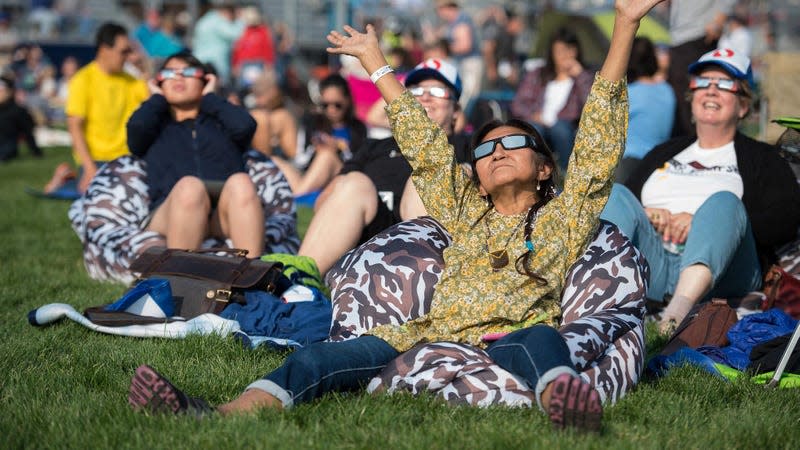
The big day—April 8—is almost upon us. Millions of people across North America are in the midst of planning for the Great North American Eclipse, and we’re here to help you get the most from this once-in-a-lifetime event.
You’re probably aware of the key details by now, but here’s a quick breakdown. The total solar eclipse, the first in North America since 2017 and remarkable for its exceptionally long path of totality, is set to cut a swath across the continent on Monday, April 8. The path of totality—the zone inside of which the Moon completely obscures the Sun—starts in Mexico, and follows a path that leads through more than a dozen U.S. states and six Canadian provinces. Partial eclipses will be seen across the entirety of North America, save for northwest Alaska and parts of Yukon and the Northwest Territories.
The upcoming solar eclipse features an unusually broad path of totality, spanning 62 to 71 miles (100 to 115 kilometers). The duration of totality will exceed four minutes, varying by location and with longer experiences closer to the path’s center.
That’s your executive summary—now onto the nitty-gritty of preparing for (and best experiencing) the upcoming stellar spectacle.
Choose your spot well in advance
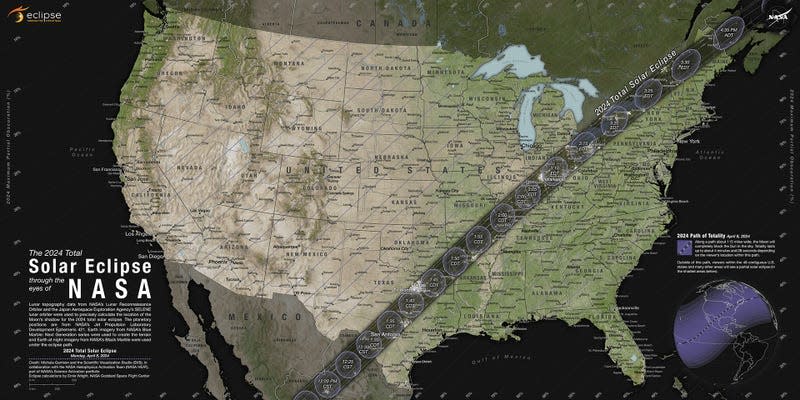
During the eclipse, a sizable portion of the North American population will witness the eclipse by simply strolling into their backyards or stepping outside their workplaces. But for those who have to travel in from afar, or wish to view the event from a particular location, the event is going to take some foresight, planning—and tons of patience.
Knowing your target location in advance will give you a decent idea of how the day will go in terms of timing. Be prepared for other people to be at your spot—possibly even crowds—as there’s a good chance that, if you think a spot is good, other people will, too. Important, but often overlooked, considerations are parking and access to bathrooms. If you’re able, be sure to leave early and give yourself a ridiculous amount of time to reach your destination. Expect bumper-to-bumper traffic.
Remember, the eclipse starts more than an hour before the totality phase. And your location matters a lot: being near the center of the path of totality will make a big difference. It can mean experiencing totality for just a few seconds, or, at its best, for an impressive four minutes.
Prepare for a long day
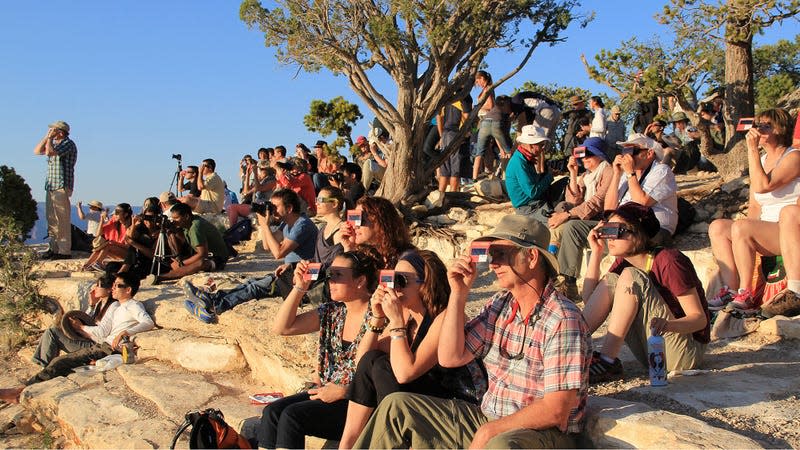
Grab a cooler and fill it with food and drinks (including extra water), and also some fun treats for yourself and the younger set. Bring any important medications along in anticipation of being stuck somewhere for a prolonged period. Other items to add to your packing list: lawn chairs, blankets, portable chargers, extra clothing in case it’s cold, hats, and sunscreen for your face (you’ll be staring directly at the Sun for hours). You should also prepare for internet outages; some locations will be rammed with high volumes of people, all vying for that precious phone reception.
On the equipment side, bring your cameras and memory cards—and make sure your cameras (or any other equipment) are fully charged and your memory cards emptied. Update any apps that haven’t been used in a while, and practice beforehand. Bring along tripods, solar filters, and a large white sheet for capturing shadow bands (more on this in just a bit). And for the love of gawd, don’t forget to bring the eclipse glasses.
On that note, you’ll want to make sure that each member of your group has their own pair of eclipse glasses (be sure they’re labeled ISO 12312-2). Sharing may be caring, but it could lead to people—particularly impatient children—wanting to catch a glimpse of the eclipse without protection.
Get the timing right

A total solar eclipse doesn’t happen all at once; the Moon slowly moves across the surface of the Sun in a process that can last for upwards of 160 minutes. Totality itself—happening in the middle of this process—can last for a few seconds to four minutes depending on your location.
At my chosen spot in southern Ontario, for example, the eclipse will begin at 2:03 p.m. ET, achieve totality at 3:18 p.m., and end at 4:31 p.m., for a total of 148 minutes. Totality at my spot will last for roughly 3 minutes and 30 seconds. NASA has an Eclipse Explorer to help you determine the times at your exact location, while the chart above can also help.
Watch the weather, but don’t let the clouds scare you
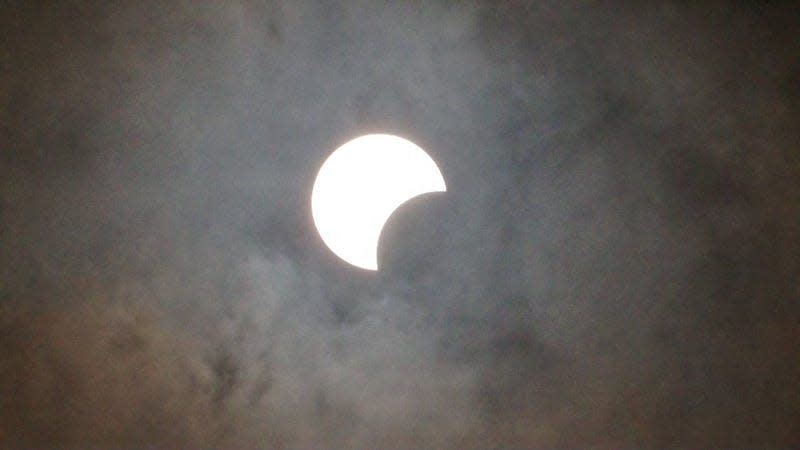
Be sure to keep track of the weather; forecasts three days in advance tend to be quite accurate. But don’t let the threat of clouds deter you. As I learned during the annular solar eclipse last October, views of the eclipse are still quite spectacular—and spooky—through wisps of clouds.
Know your eclipse phases

There are five phases to be aware of, each with something special to offer:
The opening partial eclipse phase
The onset of totality
Totality
The end of totality
The closing partial eclipse phase
The opening and closing partial eclipse phases are fun, providing sublime views of the Moon moving across the Sun. It’s during this phase that eclipse glasses must be worn to avoid serious and permanent eye damage. Cameras and telescopes must also be protected with solar filters during these opening and closing phases.
Shadow Bands

A phenomenon called shadow bands is often seen in the minutes and seconds leading up to and following totality. To view this, lay a white cloth down on the ground; this will create a uniform background, allowing these subtle, wavy lines of alternating light and dark to become visible. Shadow bands can also be seen on sidewalks, the sides of buildings, or other flat surfaces. This effect is caused by the Earth’s atmosphere refracting beams of sunlight as the Moon covers or uncovers the Sun.
Diamond Rings
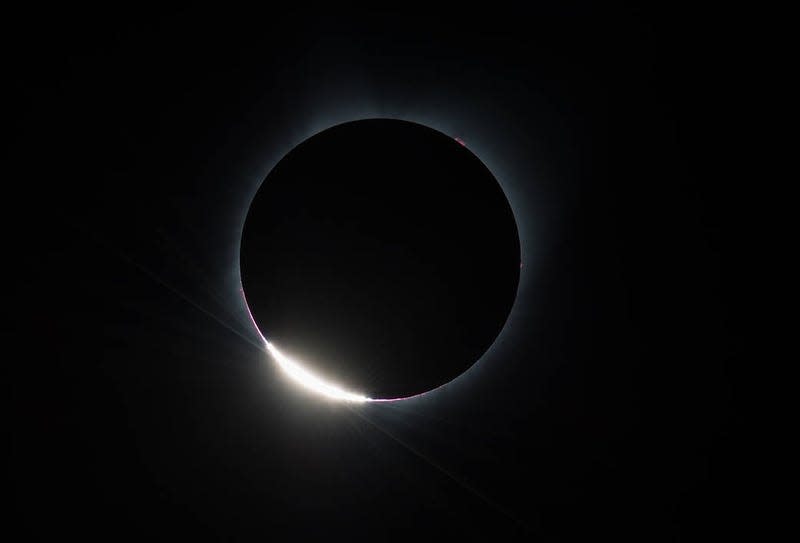
The onset of totality is that brief 15-second-long period when the partial eclipse transitions to the total eclipse. It’s during this interval that you can expect to see the Diamond Ring Effect through your eclipse glasses. As the “last bits of sunlight pass through the valleys on the moon’s limb, and the faint corona around the sun is just becoming visible, it looks like a ring with glittering diamonds on it,” NASA says.
Baily’s Beads
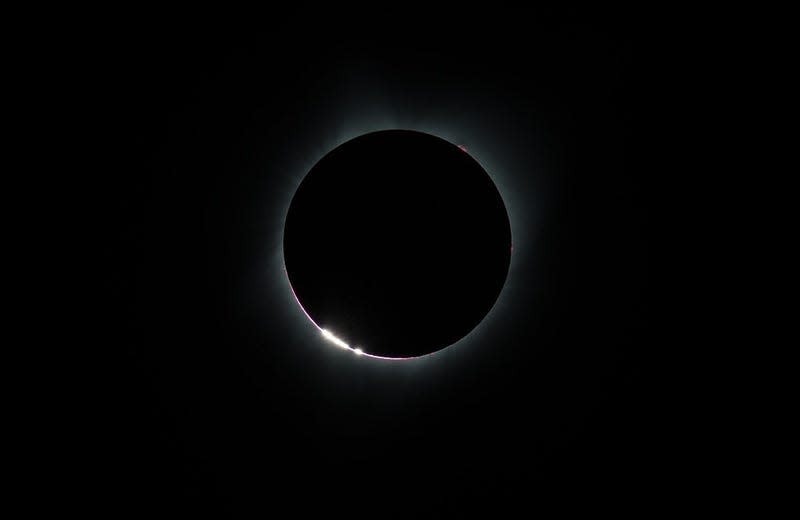
Baily’s Beads should appear next—emerging when sunlight filters through the Moon’s valleys, creating a series of luminous spots along its edge, akin to a string of beads. Make sure to watch as these beads gradually disappear until none are left, signaling the onset of totality.
What to expect during totality
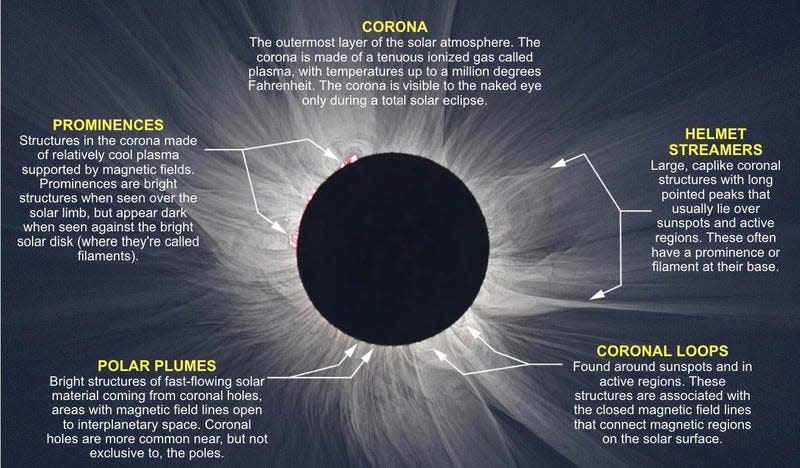
During totality, the Moon completely covers the Sun, revealing the star’s solar corona. The corona will appear as a glowing halo around the obscured Sun. Our star is currently in the active stage of its 11-year cycle, raising the possibility of flares or other solar phenomena, which could greatly enhance the experience.
Many people take off their eclipse glasses at this point to view the spectacle, but some experts advise against it, saying it’s simply not worth the risk. Here’s what NASA has to say on the matter:
Once the diamond ring disappears and there is no longer any direct sunlight, you may remove your eclipse glasses and look at the total eclipse safely with the naked eye. This moment is also called second contact. During totality, viewers may be able to see the chromosphere (a region of the solar atmosphere, appearing as the thin circle of pink around the Moon) and the corona (the outer solar atmosphere, appearing as streams of white light). Be vigilant to protect your eyes and put your eclipse glasses back on before totality ends. Totality may last only a minute or two in some locations.
During this time, you’ll notice a dramatic drop in temperature, and it’ll appear as though it’s dusk, but with the sunset all around you. Be on the lookout for Jupiter and Venus towards the horizon, and possibly even some stars.
Embrace totality, live in the moment
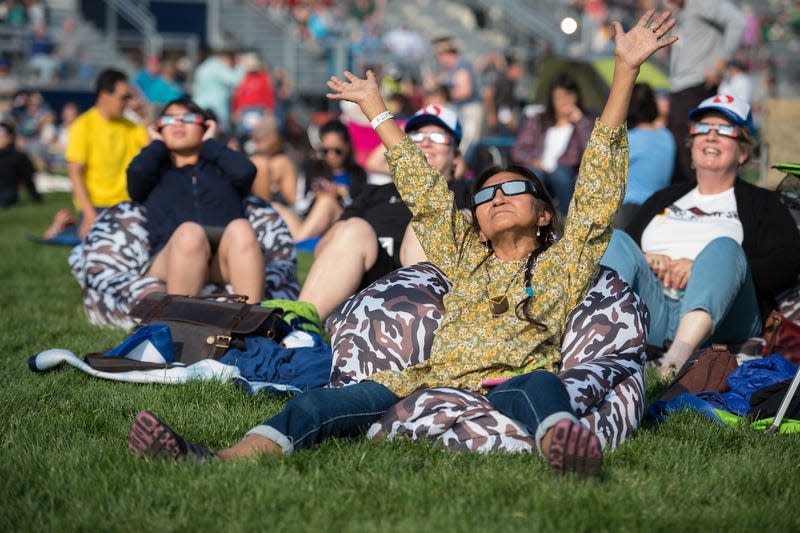
It’s at this point that you may opt to put your technology down and simply experience the eclipse as a person witnessing a rare and spectacular natural phenomenon. Let your motorized or robotic devices do the work while you take some time to be an awestruck human. If you must, grab a DSLR camera or your phone to snap some pics, but be sure to revel in the moment.
You could also use this time to do some people watching, to catch the stunned reactions of those around you. At the end of the day, photos or videos aren’t important—the real significance lies in the experience of watching the eclipse and participating in the event, be it with friends, family, or on your own.
The end
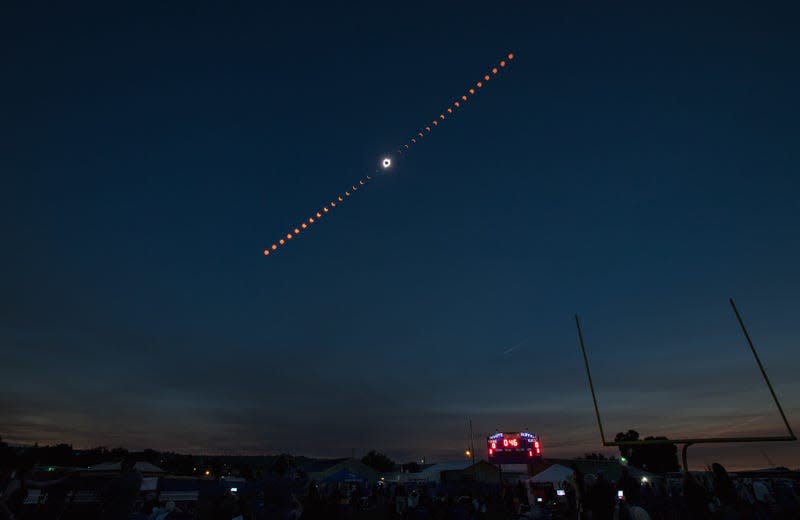
The end of totality will see a repeat of the onset phase but in reverse. It will represent another opportunity to see the Baily’s Beads and the Diamond Ring Effect. Be sure to put your eclipse glasses back on when it appears that the Baily’s Beads are coming to an end.
For many, the experience will end at this point, even though the waning eclipse phase will last for another hour or more. Personally, I’m going to hang out until the bitter end—and then some. No sense in driving during this time, given that the roads will be jammed with people all trying to head home at the same time.
Hopefully, our tips will enhance your enjoyment and appreciation of the experience. Keep in mind that, for people located outside the path of totality, the views should still be stunning, with the eerie and captivating sight of the Moon partially obscuring the Sun. Regardless of how or where you watch the eclipse, have fun, take it all in, and be safe.
For more spaceflight in your life, follow us on X and bookmark Gizmodo’s dedicated Spaceflight page.

